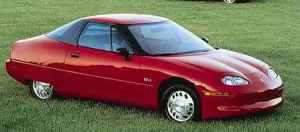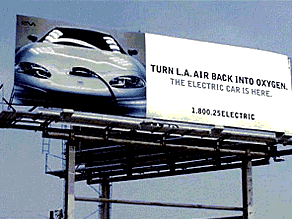The Electric Car Conspiracy… that never was
 First published in The Register, January 2008
First published in The Register, January 2008What a hit movie really tells us about innovation.
It’s almost two years since the debut of Chris Paine’s documentary Who Killed the Electric Car? The movie has been a success in US theatres and often comprises one half of a double bill with Al Gore’s An Inconvenient Truth. But what the success of the movie tells us is more alarming than any conspiracy it purports to unveil: a disdain for engineering, for technological innovation, and most of all a disdain for us, the consumers.
It’s the story of General Motors’ ill-fated EV1 electric car.
A hundred years ago, Who Killed? observes, General Motors bought up trolley car firms just to close this source of competition down. Today, it suggests, a covert alliance of Big Oil, Big Auto and corrupt regulators, both in California and in the federal government, has killed the electric car.
Vogueishly, Who Killed the Electric Car? makes transparent all the evil personalities connected around these three forces. In legal style, it finds them guilty of murdering General Motors’ two-seater Electric Vehicle 1 (EV1). It shows the usual nauseating network of silver-haired execs, lobbyists and politicos, but gives some emphasis to George W Bush (a quack salesman for hydrogen cars) and Alan Lloyd, chairman of the California Air Resources Board (CARB), 1999-2004.
Hand made
The story starts in 1996, with GM putting EV1s ‘all over California’ – or at least that’s the claim with which the film opens. In fact, GM made a total of just 800, which doesn’t say much for the machine’s real ubiquity. GM’s Saturn division built four a day, by hand. Each cost $250-500 a month to rent, which is by no means exorbitant. Quite a few EV1s were lent to celebrities, including Mel Gibson, Ted Danson. Indeed, Tom Hanks told the David Letterman show that a single charge for a range of 70-80 miles a day was all he needed personally. Anyway, Hanks proclaimed somewhat tongue in cheek, “I’m saving America”.
But GM’s heart wasn’t in it, the movie explains. From its smoked glass HQ in Detroit, the company failed to promote the EV1. GM’s ad campaign – shock, horror! – failed to feature good looking men and women. GM pointed up the car’s limitations, and Gibson and Danson were asked to make deeply bureaucratic ‘case statements’ about it. Then oil firms campaigned against the state of California spending public money on roadside electrical charging stations. Soon, too, Mobil mobilised editorials hostile to the electric car in the pages of USA Today and Newsweek.
Some time after 1987, when GM chief Roger Smith first challenged his company’s designers to come up with an electric vehicle, the California Air Resources Board became interested in the project. CARB had seen GM’s first prototype of the EV1, the fatefully misnamed Impact. In 1990, CARB passed the Zero Emission Vehicle Mandate, requiring a rising percentage of California’s cars to be free of emissions. Not too long after that, however, US car manufacturers negotiated a Master Memorandum of Agreement with CARB ensuring that the mandate require them to build the electric car only to the extent that there was consumer demand for it.
By 2003, the date at which 10 per cent of new vehicles were meant to be zero emission, CARB chairman Alan Lloyd ended the mandate. Failing to declare his recent appointment as chairman of the California Fuel Cell Partnership, Lloyd made sure that the chimera of hydrogen cars occupied everyone’s attention, and so gave the green light for GM and rival electric car essayists – Ford, Toyota, Honda – to shred their fleets.
It’s the familiar Democratic charge sheet of corporate venality, shortsightedness and friends in high places. The indictments are filmed with visual panache, but you know from the start what the verdict of this trial will be.
Morality and motoring
In 1959, the activist Ralph Nader first published an article attacking the US car industry for selling lethal products. Nader’s 1965 book Unsafe At Any Speed: The Designed-In Dangers Of The American Automobile went on to become a bestseller. Since those years Democrats have urged a health-obsessed nation to see the car not just as liberation, but also as medical nemesis.
Who Killed the Electric Car? is of a piece with all this, and of course Ralph Nader, along with a number of graying Democrats dating back to the Carter era, makes more than one appearance in the film.
Still, at least Nader makes the most penetrating accusation: that, since 1939, there’s just been too much money to be made in the technological stagnation of the internal combustion engine for carmakers to want to do more than dangle electric vehicles in front of us from time to time. And the film backs this damning verdict with a chart showing how Corporate Average Fuel Economy (CAFE) miles per gallon have stagnated at about 27.5 for the past 20 years.
But wait a minute.
The internal combustion engine has registered major gains in efficiency over recent decades. What has happened is that those gains have appeared not in fuel economy, but in vehicles that are larger and heavier.
Who Killed the Electric Car? explicitly suggests that GM made a bet on the profitable Hummer rather than the EV1. No doubt this is true; but the fact remains that capitalist innovation, though too slow for my taste, has certainly been going on in conventional automotive engines over the past few decades.
Of course, Green Democrats hate Hummers. In the movie, a dissident GM exec says that the company felt ‘schizophrenic’ about the dichotomy between clean electrical efficiency and something… ‘suburban’. The car-buying tastes of Middle America are further lambasted when the film insists that US consumers are also guilty of killing the electric car. Why? Because, apparently, they don’t want to drive like Europeans. In other words, Americans refuse to drive short distances in small cars free of luggage.
And there’s the rub.
The electric horse didn’t suit this course
Throughout Paine’s film, various figures are quoted for the fuel economy and range of electric vehicles. Something is said of acceleration, but very little is said about speed, and nothing about vehicle weight or family size.
The reason is simple. The average daily journey of Americans by car may be modest, but holidays and other trips demand a long range, just as coping for relatives demands more than a two-seater. And however one’s sensibilities might be offended by the Hummer, the fact is that the engine inside it will be way more efficient than an electric vehicle for a lot of years to come.
In other words, the electric car wasn’t murdered – it didn’t simply didn’t suit consumers’ needs. But there’s also another dimension to this fable with implications for technology innovation.
Carbon in the tank, unlike carbon in the air, is a brilliant and brilliantly compact creation. As a portable transport solution, oil-based fuel is, for the moment at least, technologically far superior to heavy batteries. Weight for weight, it carries a much bigger energy punch.
The brilliant bespectacled battery engineer Alan Cocconi, who is featured in the film, has come up with a lithium ion battery that appears to store 463 kiloJoules of energy per kilo – an energy density better than nickel metal hydride batteries (250 kJ/kg) can ever hope for, but still 100 times behind that of petrol (44,400 kJ/kg). Perhaps battery researchers at Stanford University will get the difference in energy densities down from 100 to 1 to 10 to 1; but the fact is that oil-based fuel has more than profitability going for it.
We don’t hear much about that in Who Killed the Electric Car?. Instead, loss of health, and loss generally, are the unstated themes, making it a true companion piece to An Inconvenient Truth. The film features a funeral for the electric car, complete with bagpipes (the event was held to ‘raise public awareness’ about electric vehicles, natch). At least two of the electric car’s supporters are close to tears about its demise.
What a pity that Paine’s film prefers Hollywood hyperbole and conspiracy theory to explaining the chemistry and physics of different means of propulsion. Emotional feelings shouldn’t substitute for engineering fact. ®
Fmr President of Kenya on Trump cutting off foreign aid:
“Why are you crying? It’s not your government, he has no reason to give you anything. This is a wakeup call to say what are we going to do to help ourselves?”
America first is good for the world.
Our entire Green Socialist establishment should be banged up under the ‘Online Safety’ laws, for spreading demonstrable lies (the ‘climate crisis’), causing non-trivial harm to the industrial working class, ordinary drivers, farmers, taxpayers etc, etc.
#Chagos? #Mauritius PM Navin Ramgoolam "is reported to want Starmer to pay £800m a year, plus ‘billions of pounds in #reparations’." (14 January) https://www.spiked-online.com/2025/01/14/the-chagos-islands-deal-is-an-embarrassment/
Now the Torygraph wakes up https://telegraph.co.uk/gift/1ff8abbb462cd609
Read @spikedonline - first with the news!
Articles grouped by Tag
Bookmarks
Innovators I like

Robert Furchgott – discovered that nitric oxide transmits signals within the human body

Barry Marshall – showed that the bacterium Helicobacter pylori is the cause of most peptic ulcers, reversing decades of medical doctrine holding that ulcers were caused by stress, spicy foods, and too much acid

N Joseph Woodland – co-inventor of the barcode

Jocelyn Bell Burnell – she discovered the first radio pulsars

John Tyndall – the man who worked out why the sky was blue

Rosalind Franklin co-discovered the structure of DNA, with Crick and Watson

Rosalyn Sussman Yallow – development of radioimmunoassay (RIA), a method of quantifying minute amounts of biological substances in the body

Jonas Salk – discovery and development of the first successful polio vaccine

John Waterlow – discovered that lack of body potassium causes altitude sickness. First experiment: on himself

Werner Forssmann – the first man to insert a catheter into a human heart: his own

Bruce Bayer – scientist with Kodak whose invention of a colour filter array enabled digital imaging sensors to capture colour

Yuri Gagarin – first man in space. My piece of fandom: http://www.spiked-online.com/newsite/article/10421

Sir Godfrey Hounsfield – inventor, with Robert Ledley, of the CAT scanner

Martin Cooper – inventor of the mobile phone

George Devol – 'father of robotics’ who helped to revolutionise carmaking

Thomas Tuohy – Windscale manager who doused the flames of the 1957 fire

Eugene Polley – TV remote controls




0 comments